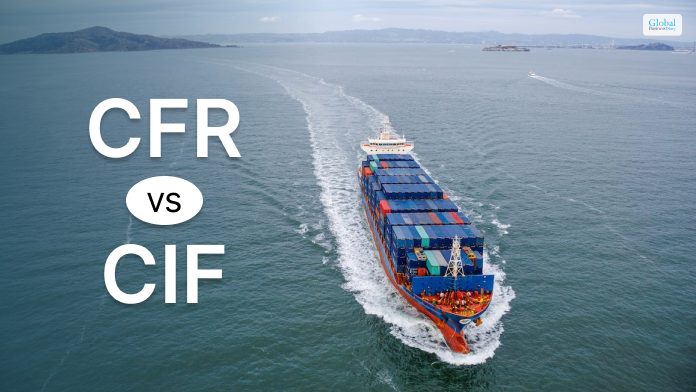CFR Vs CIF: What Are The Differences Between These Shipping Terms?

CFR vs CIF: What is the difference between the terms? – You will find both terms standard in shipping and transport, and both are part of international trade rules. CFR is a trade term that means the seller will transport goods by sea to the destination port. On the other hand, CIF means that the seller pays to cover the cost of shipping and insurance to ensure there is no potential damage or loss for the buyer.
In this article, you will learn about two popular terms in shipping: CIF and CFR. First, we will get a general overview of both the terms. Then, we will discuss the function of the seller in both cases. Finally, we will examine the differences between the two terms. Hence, to learn more about the two terms, read on to the end of the article.
CFR Vs CIF: An Overview Of The Terms
One of the interesting things about both terms is that they are known as incoterms.
According to Indeed.com,
“Incoterms are common trade rules developed by the International Chamber of Commerce (ICC). They define the responsibilities of sellers and buyers while participating in international trade. CIF is an Incoterm specifically meant for shipping across oceans or international waters. There are other internationally recognized Incoterm that buyers and sellers can use when delivering products.”
Furthermore, both are part of the larger group of international trade rules. The International Chamber of Commerce (ICC) devised the rules. The first version of the rules came out in 1936. both terms consist of guidelines for traders.
Basically, CFR and CIF are similar terms. However, in CIF, the seller will also need to pay for the marine insurance to offer protection against loss, destruction, and damage to the order.
What Is Cost And Freight (CFR)?
As per Investopedia’s definition,
“Cost and freight (CFR) is a legal term used in foreign trade contracts. In a contract specifying that a sale is cost and freight, the seller is required to arrange for the carriage of goods by sea to a port of destination and provide the buyer with the documents necessary to obtain them from the carrier.”
This term strictly finds its use in cases of cargo transport through sea or inland waterways. However, in this case, the seller does not have the responsibility of procuring marine insurance, as is the case with CIF. The insurance is to provide protection against the risk of loss or damage to the product during transit.
What Is Cost, Insurance, And Freight (CIF)?
On the other hand, CIF (cost, insurance, and freight) gives responsibilities to both buyers and sellers. This is also the case in the case of deliveries through transport through seas or inland waterways. The term gives information about who will merchandise the shipment and when.
If you follow the rules of a CIF agreement, you will be able to divide your shipping costs. Apart from that, you will also have a basic understanding of when you have responsibility for the shipment in the shipping process.
With the CIF agreement, you are transferring both your costs and your risks, but at different times. Here, as a seller, you are transferring the cost when the financial responsibility of the product shifts from the seller to the buyer. Generally, the cost transfer occurs when the product reaches the destination port. Here, you will have to take responsibility for any merchandise cost before that.
The risk transfer happens when the responsibility for the lost or damaged item shifts from the seller to the buyer. In this agreement, this risk transfer happens after the goods are loaded onto the ship. Hence, while the goods are traveling, the seller is responsible for handling shipping costs. However, the buyer will be responsible for the damages to the merchandise or in case of loss.
CFR Vs CIF: What Are The Differences?
According to Investopedia,
“Each term refers to an agreement governing the responsibilities of shipping that fall respectively to buyers and sellers in an international trade transaction. This system of agreements aids in an orderly process of international trade by making contract models available that are easy to identify and understand in all languages.”
However, there are some primary differences between the two agreements. The major difference lies in one additional responsibility for the seller (shipper). In the case of CIF, the seller must also provide a minimum amount of marine insurance on the shipped goods.
Here, the buyer and seller agree on the insurance amount beforehand. Apart from that, the seller of the product takes up the responsibility for additional costs related to the transportation of the product. In addition to that, the seller also pays for paperworks, custom inspections, rerouting, etc., that might occur during the transport of the product. However, the buyer here has to take responsibility for any damage to goods or even loss during transit.
CFR Vs CIF: Understanding The Difference With Example
You can understand the difference between CFR and CIF easily with the help of this example.
Let’s say Seller X sells a particular good from Spain to Buyer Y in the United States. Here, Seller X pays for the shipping from Spain to the US. Also, the seller is responsible for the shipment until the goods are loaded on the shipping vessel. After the loading of the vessel, Buyer Y takes over the responsibility for the goods. This agreement is the same for both CFR and CIF.
However, under CIF, there are additional responsibilities for Seller X. Here, Seller X needs to buy insurance for the transfer of goods. With the insurance, the seller will need to cover the loss or damage to the goods at the time of shipment. Eventually, after the goods reach the destination port, the seller does not have any responsibility.
Wrapping Up
CFR vs CIF – Hope you have found an understanding of both the terms and the differences between them. You can see from the article that both are quite similar agreements. However, in the case of CIF, the seller bears an additional responsibility.
Do you have more information to add? Consider sharing them with us in the comments section below.
Find More About Business By Clicking Below!!













